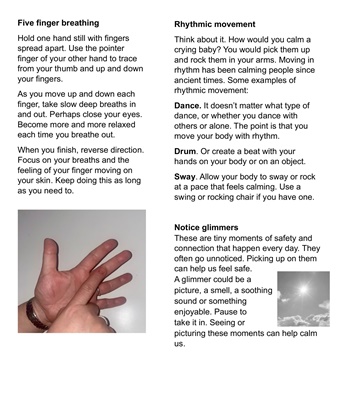
Rhythmic movement
Think about it. How would you calm a crying
baby? You would pick them up and rock
them in your arms. Moving in rhythm has
been calming people since ancient times.
Some examples of rhythmic movement:
Dance. It doesn't matter what type of dance,
or whether you dance with others or alone.
The point is that you move your body with
rhythm.
Drum. Or create a beat with your hands on
your body or on an object.
Sway. Allow your body to sway or rock at a
pace that feels calming. Use a swing or
rocking chair if you have one.
TIPS
When strong emotions hit, it
can be hard to think. Try some
of these:
· Energy too high? Try things
that feel soothing and calming.
· Energy too low? Try things
that feel energizing and alerting.
· Any time Use things that feel
grounding and comforting.
Reduce or avoid unhelpful
sensations.
Consider ways to reduce their
effect. For example, wear
headphones, sunglasses, comfy
clothes. Limit time on social
media and the news.
Five finger breathing
Hold one hand still with fingers spread apart.
Use the pointer finger of your other hand to
trace from your thumb and up and down your
fingers.
As you move up and down each finger, take
slow deep breaths in and out. Perhaps close
your eyes. Become more and more relaxed
each time you breathe out.
When you finish, reverse
direction. Focus on your
breaths and the feeling of
your finger moving on your
skin. Keep doing this as
long as you need to.